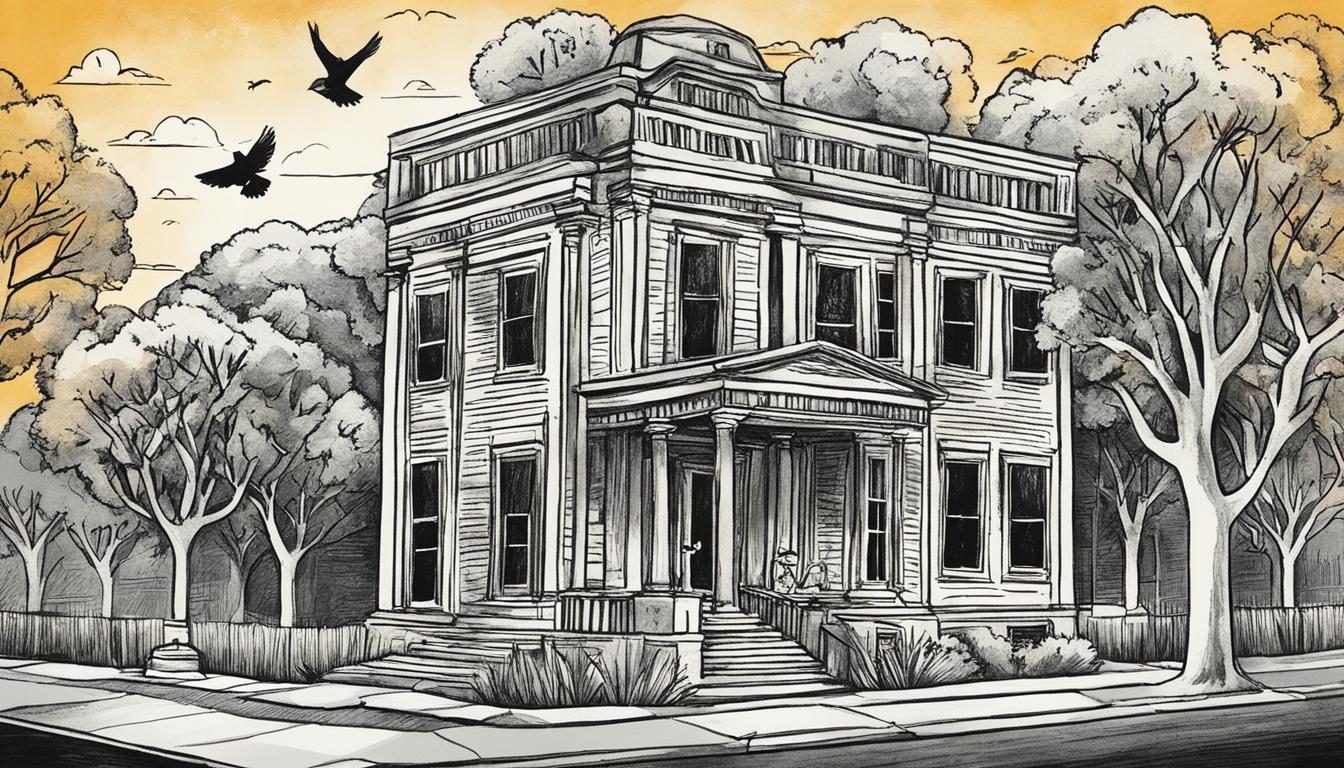Welcome to our audiobook review of the timeless classic novel, “To Kill a Mockingbird,” written by Harper Lee in 1960. This coming-of-age story set in Maycomb, Alabama, offers a powerful and poignant message that resonates with readers even today. In this article, we will provide an overview of the story as well as a critical analysis of the audiobook performance. Stay with us to discover why “To Kill a Mockingbird” continues to inspire generations.
About “To Kill a Mockingbird”
Harper Lee’s To Kill a Mockingbird is a classic novel that has resonated with readers since its publication in 1960. Set in the fictional town of Maycomb, Alabama, during the Great Depression, the book tells the story of Scout Finch, her brother Jem, and their father, Atticus Finch, a lawyer who defends a black man falsely accused of rape. Through the eyes of Scout, Lee explores themes of justice, racism, and courage, delivering a timeless message that remains relevant today.
The novel has become a literary classic, captivating readers with its southern gothic style, powerful characters, and gripping plot. It has been translated into more than 40 languages, with over 50 million copies sold worldwide.
| Author | Harper Lee |
|---|---|
| Publication Date | 1960 |
| Genre | Classic and Southern Gothic |
| Setting | Maycomb, Alabama, during the Great Depression |
| Themes | Racism, justice, innocence, and courage |
“The book to read is not the one that thinks for you but the one which makes you think.” – Harper Lee
Summary of “To Kill a Mockingbird”
“To Kill a Mockingbird” by Harper Lee follows the story of Scout Finch, a young girl growing up in the fictional town of Maycomb, Alabama during the Great Depression era. The central theme of the book explores racial inequality and social injustice amidst a time when Jim Crow laws were prevalent in the United States.
The book is narrated by adult Scout, looking back on her childhood experiences. Scout’s father, Atticus Finch, is a respected lawyer in Maycomb, and he takes on the case of Tom Robinson, a Black man falsely accused of raping a white woman. Despite a lack of evidence, Tom is found guilty by an all-white jury. The unfair verdict highlights the deeply ingrained prejudice in the town’s justice system.
Alongside the trial, the story also follows Scout and her brother, Jem, as they explore the town and encounter its residents, including the reclusive Boo Radley. The children take great interest in uncovering the mystery surrounding Boo’s life, leading to unexpected events.
The book ultimately explores themes of justice, courage, innocence, racism and societal norms. The poignant story has become a timeless classic that continues to resonate with readers today, nearly six decades after its initial publication.
Key Events
The key events in “To Kill a Mockingbird” include the trial of Tom Robinson, the children’s fascination with Boo Radley and their eventual encounter with him, and the climactic events that occur on Halloween night. Through these events, the story highlights the complex and often devastating dynamics of race relations in the Deep South.
Central Themes
The central themes in “To Kill a Mockingbird” include the injustices of racism and social inequality, the courage it takes to stand up against these injustices, and the corruption of societal norms. Through the use of vivid characters and poignant storytelling, Lee drives home these themes and conveys their relevance in contemporary society.
Characters in “To Kill a Mockingbird”
Harper Lee masterfully crafted complex characters in “To Kill a Mockingbird,” each with their own story to tell. Let’s take a closer look at some of the main players:
| Name | Role | Development | Significance |
|---|---|---|---|
| Scout Finch | The protagonist and narrator of the story, a young girl with a curious mind and an independent spirit. | Throughout the story, Scout grapples with issues of gender, race, and societal norms, and matures considerably as a result. | Scout provides a childlike perspective on the events of the novel and serves as a vehicle for exploring some of the book’s major themes. |
| Atticus Finch | Scout’s father, a respected lawyer in Maycomb who stands up for what is right, even in the face of opposition. | Atticus serves as a role model for both his children and the community, consistently displaying honesty, integrity, and compassion. | His defense of Tom Robinson underscores the book’s themes of justice, ethics, and morality. |
| Boo Radley | A reclusive neighbor who is the subject of much curiosity and speculation among the children in Maycomb. | The truth about Boo and his backstory are gradually revealed throughout the progression of the novel. | Boo’s character serves to emphasize the themes of prejudice, empathy, and the dangers of prejudice propagated by ignorance. |
| Jem Finch | Scout’s older brother, who experiences his own coming-of-age journey throughout the novel. | As Jem grows older and witnesses the injustices of the world, he struggles with disillusionment, grief, and a loss of innocence. | Like Scout, Jem’s character development serves to highlight some of the major themes that run through “To Kill a Mockingbird.” |
Writing Style and Language in “To Kill a Mockingbird”
Harper Lee’s writing style in “To Kill a Mockingbird” is renowned for its literary merit. Her language is direct and precise, often incorporating vivid imagery to evoke the sights and sounds of Maycomb, Alabama. The Southern dialect is also a notable feature of the book, adding an element of authenticity to the setting.
Lee’s writing style is characterized by her use of symbolism, which enhances the themes of the book and deepens the narrative. She weaves together a complex web of meanings and motifs, inviting readers to reflect on the nature of justice, prejudice, and morality.
“Shoot all the blue jays you want, if you can hit ’em, but remember it’s a sin to kill a mockingbird.”
This quote is one of the most iconic in the book and serves as a powerful metaphor for the way in which innocent individuals are often targeted and persecuted in society. Lee’s use of language to convey this message is masterful.
Furthermore, the Southern dialect adds a layer of richness to the text, giving the book a sense of place and time that is difficult to replicate. The use of colloquialisms and regional expressions adds authenticity to the characters and their experiences, making the book all the more immersive.
In conclusion, Harper Lee’s writing style and use of language in “To Kill a Mockingbird” are integral to the book’s overall impact and success. Her masterful prose, combined with the authenticity of the Southern dialect, makes the book a timeless masterpiece that continues to resonate with readers today.
Historical and Social Context of “To Kill a Mockingbird”
“To Kill a Mockingbird” is set in the 1930s during the Great Depression, a time of widespread poverty and unemployment in the United States. The book explores the racial inequality and prejudice of the Jim Crow laws that were prevalent during this era.
The Jim Crow laws were a set of state and local laws in the Southern United States that enforced racial segregation and discrimination against Black Americans, lasting from the late 1800s until the 1960s. These laws denied Black Americans basic human rights, including the right to vote, access to education, and fair treatment in the justice system.
The Great Depression added to the social inequality of this time period. The economic downturn left many Americans struggling to make ends meet, with widespread poverty and mass unemployment. This created a difficult environment in which to fight for social justice and equal rights.
Against this backdrop, Harper Lee’s “To Kill a Mockingbird” tells the story of a young girl named Scout in the fictional town of Maycomb, Alabama. The novel explores themes of racial injustice, morality, and the loss of innocence through the eyes of Scout and her family. Lee’s powerful writing shines a light on the struggles faced by Black Americans during this tumultuous time in American history.”
Themes Explored in “To Kill a Mockingbird”
In “To Kill a Mockingbird,” Harper Lee explores several prominent themes that contribute to the overall narrative and message of the book.
Racism
One of the most significant themes in the book is racism, which is explored throughout the story in various ways. From the unjust trial of Tom Robinson to the racist attitudes of many characters in the novel, Lee sheds light on the pervasive nature of racism in American society.
Justice
Another key theme in the book is justice. Through the character of Atticus Finch, Lee presents a vision of justice that is based on fairness, equality, and the rule of law. However, the book also highlights the obstacles that stand in the way of achieving justice in a society that is often unfair and unequal.
Innocence
The theme of innocence is also present throughout “To Kill a Mockingbird.” Through the character of Scout, Lee presents a vision of childhood innocence that is pure, honest, and uncorrupted by the prejudices of society. However, the book also highlights the loss of innocence that can occur as children are introduced to the harsh realities of the world around them.
Courage
The final theme explored in “To Kill a Mockingbird” is courage. Both Atticus and Scout demonstrate courage in their fight against injustice, racism, and inequality. Lee presents a vision of courage that is not about physical strength, but rather about standing up for what is right, even in the face of adversity.
Reception and Impact of “To Kill a Mockingbird”
Since its publication in 1960, Harper Lee’s “To Kill a Mockingbird” has received critical acclaim, becoming an instant classic and a staple in American literature. The novel won the prestigious Pulitzer Prize in 1961, cementing its place as a timeless masterpiece.
The cultural significance of “To Kill a Mockingbird” cannot be overstated. The book has not only been widely read and celebrated for its powerful themes of justice, racism, and courage, but it has also inspired countless adaptations, including a successful film adaptation in 1962 starring Gregory Peck. The story has become a cultural touchstone and an essential part of the American literary canon, resonating with readers of all ages and backgrounds.
Over the years, “To Kill a Mockingbird” has also sparked important discussions around race, inequality, and social justice. The novel’s message remains as relevant today as it was over 60 years ago, reminding readers of the need to fight for justice and equality for all.
Awards won by “To Kill a Mockingbird”
| Award | Year |
|---|---|
| Pulitzer Prize for Fiction | 1961 |
| Brooker Prize | 1961 |
| Outstanding Production of a Play or Musical (Tony Award) | 2019 |
| Grammy Award for Best Spoken Word Album | 2007 |
As evidenced by the numerous awards and accolades it has received, “To Kill a Mockingbird” remains a literary masterpiece with a lasting impact on readers and society as a whole. It continues to be a powerful reminder of the importance of empathy, justice, and the continued fight for a more equal world.
Audiobook Performance of “To Kill a Mockingbird”
If you’re a fan of audiobooks, you may be wondering how well “To Kill a Mockingbird” translates to audio format. Fortunately, the audiobook performance of this classic novel is exceptional, making it a must-listen for fans of the book. The audiobook is narrated by Sissy Spacek, who brings the characters and setting of Maycomb to life with her captivating voice.
The quality of the audio production is also remarkable, with clear and well-balanced sound that complements the story. If you’re unfamiliar with Southern dialect, you may need to adjust to some of the accents used in the audiobook, but it ultimately adds to the authenticity of the book’s setting.
The Narration
Sissy Spacek’s narration of “To Kill a Mockingbird” is nothing short of excellent. Her voice perfectly captures the youthful innocence of Scout Finch while also bringing depth to the character’s growth and development throughout the book. Spacek’s narration of the other characters, including Atticus and Jem Finch and Boo Radley, is equally impressive, with each voice distinctive and believable.
“Sissy Spacek’s narration of ‘To Kill a Mockingbird’ is nothing short of excellent.”
The Voice Actors
Aside from Spacek’s narration, the audiobook also features a cast of voice actors who bring life and dimension to the characters. For example, Cassandra Campbell provides the voice of Miss Maudie Atkinson, while Bahni Turpin voices Calpurnia. The inclusion of several voice actors adds a layer of depth to the storytelling that is not present in the book version.
The Audio Production
The overall audio production of “To Kill a Mockingbird” is top-notch. The sound quality is clear and free of distracting background noises, which can often be an issue with audiobooks. The audiobook is also well-paced, allowing for the listener to fully absorb the story without feeling rushed or overwhelmed.
If you’re a fan of audiobooks, or if you’re interested in experiencing “To Kill a Mockingbird” in a new way, we highly recommend giving the audiobook a listen. The combination of Sissy Spacek’s narration, the talented voice actors, and the excellent audio production make it a standout adaptation of this iconic novel.

Comparisons to the Film Adaptation of “To Kill a Mockingbird”
When Harper Lee’s “To Kill a Mockingbird” was adapted for the big screen, it quickly became a cinematic classic. The film adaptation, which premiered in 1962, starred Gregory Peck as Atticus Finch, the moral center of the story. Despite some differences, the movie remains a faithful adaptation of the source material, capturing the spirit of Lee’s writing and delivering a memorable cinematic experience.
One of the key differences between the book and the movie version of “To Kill a Mockingbird” is the pacing. The film condenses and simplifies sections of the plot, resulting in a brisker and more straightforward storytelling experience. Some of the minor characters and subplots from the novel were left out, but the overall message and themes of the book remained intact.
“The movie version of ‘To Kill a Mockingbird’ is a triumph of storytelling and filmmaking, capturing the essence of Harper Lee’s novel while also providing its own unique interpretation of the material.” – Film critic Roger Ebert
Aside from Gregory Peck’s iconic performance as Atticus Finch, the film adaptation also stood out for its visual style and cinematography. Director Robert Mulligan used shadow and light to create a moody and atmospheric feel, which complemented the tense nature of the story. The use of music and sound effects also enhanced the viewing experience, creating a sense of tension and emotional weight.
That being said, there were a few changes to the characters and their arcs in the movie adaptation of “To Kill a Mockingbird.” Some characters were portrayed in a slightly different manner, and certain events were altered to fit the shorter runtime. However, these changes did not detract from the overall quality of the film and its ability to convey the themes of Lee’s novel.
All in all, the film adaptation of “To Kill a Mockingbird” is a prime example of how to translate literature to the big screen. Although it may not be a perfectly faithful adaptation, it succeeds in capturing the heart and soul of Lee’s writing, and remains a beloved cinematic interpretation of this classic novel.
Contemporary Relevance of “To Kill a Mockingbird”
Despite being published in 1960, “To Kill a Mockingbird” remains a relevant and powerful piece of literature with important lessons that still resonate today. The novel’s exploration of social justice, racial discrimination, and the fight for equality continues to spark important discussions and inspire change.
“The one thing that doesn’t abide by majority rule is a person’s conscience.” – Atticus Finch, To Kill a Mockingbird
The book’s central themes take on even greater significance when examined in the context of present-day events. The ongoing struggle for racial justice and equality highlights the enduring relevance of the issues addressed in “To Kill a Mockingbird.”
Furthermore, the novel’s timeless message has continued to resonate with readers of all ages and backgrounds, cementing its status as a classic piece of American literature. With its poignant commentary on the human experience, “To Kill a Mockingbird” remains a must-read for anyone interested in exploring important issues and engaging with complex social and moral questions.
Critical Analysis of “To Kill a Mockingbird”
In “To Kill a Mockingbird,” Harper Lee invites readers to explore a fictional world of deep symbolism and themes. The novel’s narrative structure is an essential aspect of its success, with Lee employing various literary techniques to convey a story that resonates on multiple levels.
Symbolism
One of the most striking aspects of “To Kill a Mockingbird” is its use of symbolism. The mockingbird, for instance, is a prominent symbol throughout the book, representing innocence and purity. Boo Radley, too, is a symbolic figure, embodying the societal norms and expectations that oppress individuality and difference.
Narrative Structure
The narrative structure of “To Kill a Mockingbird” is masterful, with Lee effortlessly weaving together different plot threads and timelines. The novel’s opening line, “When he was nearly thirteen, my brother Jem got his arm badly broken at the elbow,” immediately engages readers and sets up key plot points that will later be addressed.
“The narrative structure of “To Kill a Mockingbird” is masterful, with Lee effortlessly weaving together different plot threads and timelines.”
Literary Analysis
On a deeper level, “To Kill a Mockingbird” also provides a rich landscape for literary analysis. Lee explores themes such as racism, power, and identity, and uses vivid imagery and metaphor to evoke emotional and intellectual responses in readers. Her writing style is deceptively simple, yet her use of language is deliberate and highly effective in conveying the novel’s themes and ideas.
Recommendations for “To Kill a Mockingbird” Audiobook
If you’re a fan of classic literature and want to experience “To Kill a Mockingbird” in a unique way, we highly recommend listening to the audiobook version. Here are some top picks to consider:
| Audiobook Title | Narrator |
|---|---|
| To Kill a Mockingbird: Narrated by Sissy Spacek | Sissy Spacek |
| To Kill a Mockingbird: Narrated by Garrison Keillor | Garrison Keillor |
| To Kill a Mockingbird: Narrated by Bahni Turpin | Bahni Turpin |
Each of these narrators brings a unique perspective to the story, elevating the reading experience with their distinct styles and voices. Sissy Spacek, in particular, delivers a mesmerizing performance that captures the essence of Scout’s personality and the Southern setting of Maycomb. If you’re not sure which narrator to choose, we suggest listening to a sample of each and seeing which one resonates with you the most.
“Sissy Spacek’s narration of ‘To Kill a Mockingbird’ is a testament to the power of a solo performance. Spacek stands quietly while the choir sings around her, lending full heart and soul to each character from the innocent Scout to the wise Miss Maudie. Her nuanced performance makes this classic tale come alive and should resonate with listeners of all ages.” – AudioFile magazine
Whether you’re a first-time reader or a longtime fan of “To Kill a Mockingbird,” the audiobook version is a great way to experience this seminal novel in a whole new light.

Other Works by Harper Lee
Besides To Kill a Mockingbird, Harper Lee only published one other novel during her lifetime – Go Set a Watchman. This previously unknown companion piece to To Kill a Mockingbird was controversially published in 2015, amid questions about its authorship and authenticity.
Lee’s other works include a handful of shorter pieces, such as “Love – In Other Words” and “Christmas to Me,” as well as some unpublished works, including “The Long Goodbye.”
Despite not having a large bibliography, Harper Lee’s impact on American literature is undeniable. Both To Kill a Mockingbird and Go Set a Watchman continue to spark conversations and remain popular in contemporary society.
Conclusion
“To Kill a Mockingbird” by Harper Lee is a classic novel that continues to resonate with readers today. Its exploration of themes such as justice, racism, and courage remains as relevant now as it was when the book was first published.
The audiobook adaptation of “To Kill a Mockingbird” provides an accessible and engaging way to experience the story, making it an excellent choice for fans of classic literature.
Whether you choose to read the book or listen to the audiobook, “To Kill a Mockingbird” is a literary masterpiece that deserves a place on your shelf.
And for those interested in exploring more of Harper Lee’s work, “Go Set a Watchman” and other titles in her bibliography offer further insight into this talented author’s unique perspective and writing style.



